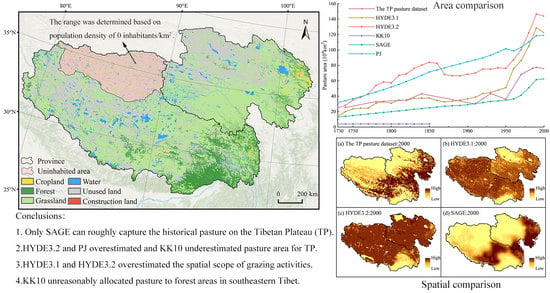Uncertainties of Global Historical Land Use Datasets in Pasture Reconstruction for the Tibetan Plateau
Abstract
:1. Introduction
2. Materials and Methods
2.1. Study Area
2.2. Global Historical Land Use Datasets
2.2.1. The HYDE Dataset
2.2.2. The KK10 Dataset
2.2.3. The SAGE Dataset
2.2.4. The PJ Dataset
2.3. Historical Pasture Dataset for the Tibetan Plateau
2.4. Evaluation Methods
3. Results
3.1. The Reliability of the TP Pasture Dataset
3.2. Uncertainty of Pasture Area in Global Datasets
3.2.1. Qualitative Assessment Based on Historical Records
3.2.2. Quantitative Comparison Based on the TP Pasture Dataset
3.3. Uncertainty of Pasture’s Spatial Pattern in the Global Datasets
3.3.1. Comparison of Overall Spatial Pattern
3.3.2. Comparison at the Grid Scale
4. Discussion
4.1. Estimation of Pasture Area
4.2. Spatial Allocation of Pasture Area
5. Conclusions
Author Contributions
Funding
Data Availability Statement
Conflicts of Interest
References
- Ellis, E.C.; Ramankutty, N. Putting people in the map: Anthropogenic biomes of the world. Front. Ecol. Environ. 2008, 6, 439–447. [Google Scholar] [CrossRef] [Green Version]
- Venter, O.; Sanderson, E.W.; Magrach, A.; Allan, J.R.; Beher, J.; Jones, K.R.; Possingham, H.P.; Laurance, W.F.; Wood, P.; Fekete, B.M.; et al. Sixteen years of change in the global terrestrial human footprint and implications for biodiversity conservation. Nat. Commun. 2016, 7, 12558. [Google Scholar] [CrossRef] [PubMed] [Green Version]
- Du, M.; Kawashima, S.; Yonemura, S.; Zhang, X.; Chen, S. Mutual influence between human activities and climate change in the Tibetan Plateau during recent years. Glob. Planet. Chang. 2004, 41, 241–249. [Google Scholar] [CrossRef]
- Foley, J.A.; DeFries, R.; Asner, G.P.; Barford, C.; Bonan, G.; Carpenter, S.R.; Chapin, F.S.; Coe, M.T.; Daily, G.C.; Gibbs, H.K.; et al. Global consequences of land use. Science 2005, 309, 570–574. [Google Scholar] [CrossRef] [PubMed] [Green Version]
- Díaz, S.; Settele, J.; Brondízio, E.S.; Ngo, H.T.; Agard, J.; Arneth, A.; Balvanera, P.; Brauman, K.A.; Butchart, S.H.M.; Chan, K.M.A.; et al. Pervasive human-driven decline of life on Earth points to the need for transformative change. Science 2019, 366, eaax3100. [Google Scholar] [CrossRef] [Green Version]
- Pereira, H.M.; Navarro, L.M.; Martins, I.S. Global Biodiversity Change: The Bad, the Good, and the Unknown. Annu. Rev. Environ. Resour. 2012, 37, 25–50. [Google Scholar] [CrossRef] [Green Version]
- Johnson, C.N.; Balmford, A.; Brook, B.W.; Buettel, J.C.; Galetti, M.; Guangchun, L.; Wilmshurst, J.M. Biodiversity losses and conservation responses in the Anthropocene. Science 2017, 356, 270–275. [Google Scholar] [CrossRef]
- Stephens, L.; Fuller, D.; Boivin, N.; Rick, T.; Gauthier, N.; Kay, A.; Marwick, B.; Armstrong, C.G.; Barton, C.M.; Denham, T.; et al. Archaeological assessment reveals Earth’s early transformation through land use. Science 2019, 365, 897–902. [Google Scholar] [CrossRef] [Green Version]
- van Asselen, S.; Verburg, P.H. A Land System representation for global assessments and land-use modeling. Glob. Chang. Biol. 2012, 18, 3125–3148. [Google Scholar] [CrossRef] [Green Version]
- Gaillard, M.J.; Morrison, K.D.; Madella, M.; Whitehouse, N. Past land-use and land-cover change: The challenge of quantification at the subcontinental to global scales. Past Glob. Chang. Mag. 2018, 26, 3. [Google Scholar] [CrossRef] [Green Version]
- Brown, A.; Poska, A.; Pluskowski, A. The environmental impact of cultural change: Palynological and quantitative land cover reconstructions for the last two millennia in northern Poland. Quat. Int. 2019, 522, 38–54. [Google Scholar] [CrossRef]
- Klein Goldewijk, K. Estimating global land use change over the past 300 years: The HYDE Database. Glob. Biogeochem. Cycles 2001, 15, 417–433. [Google Scholar] [CrossRef]
- Klein Goldewijk, K.; Beusen, A.; Van Drecht, G.; De Vos, M. The HYDE 3.1 spatially explicit database of human-induced global land-use change over the past 12,000 years. Glob. Ecol. Biogeogr. 2011, 20, 73–86. [Google Scholar] [CrossRef]
- Klein Goldewijk, K.; Beusen, A.; Doelman, J.; Stehfest, E. Anthropogenic land use estimates for the Holocene—HYDE3.2. Earth Syst. Sci. Data 2017, 9, 927–953. [Google Scholar] [CrossRef] [Green Version]
- Ramankutty, N.; Evan, A.T.; Monfreda, C.; Foley, J.A. Farming the planet: 1. Geographic distribution of global agricultural lands in the year 2000. Glob. Biogeochem. Cycles 2008, 22, GB1003. [Google Scholar] [CrossRef]
- Ramankutty, N. Global Cropland and Pasture Data from 1700–2007; The LUGE (Land Use and the Global Environment) Laboratory, McGill University: Montreal, QC, Canada, 2012. [Google Scholar]
- Pongratz, J.; Reick, C.H.; Raddatz, T.; Claussen, M.J. A reconstruction of global agricultural areas and land cover for the last millennium. Glob. Biogeochem. Cycles 2008, 22, GB3018. [Google Scholar] [CrossRef]
- Kaplan, J.O.; Krumhardt, K.M.; Zimmermann, N. The prehistoric and preindustrial deforestation of Europe. Quat. Sci. Rev. 2009, 28, 3016–3034. [Google Scholar] [CrossRef]
- Kaplan, J.O.; Krumhardt, K.M.; Ellis, E.C.; Ruddiman, W.F.; Lemmen, C.; Klein Goldewijk, K. Holocene carbon emissions as a result of anthropogenic land cover change. Holocene 2011, 21, 775–791. [Google Scholar] [CrossRef] [Green Version]
- Ellis, E.C.; Klein Goldewijk, K.; Siebert, S.; Lightman, D.; Ramankutty, N. Anthropogenic transformation of the biomes, 1700 to 2000. Glob. Ecol. Biogeogr. 2010, 19, 589–606. [Google Scholar] [CrossRef]
- Ellis, E.C.; Kaplan, J.O.; Fuller, D.Q.; Vavrus, S.; Klein Goldewijk, K.; Verburg, P.H. Used planet: A global history. Proc. Natl. Acad. Sci. USA 2013, 110, 7978–7985. [Google Scholar] [CrossRef] [Green Version]
- He, F.; Vavrus, S.J.; Kutzbach, J.E.; Ruddiman, W.F.; Kaplan, J.O.; Krumhardt, K.M. Simulating global and local surface temperature changes due to Holocene anthropogenic land cover change. Geophys. Res. Lett. 2014, 41, 623–631. [Google Scholar] [CrossRef]
- Houghton, R.A.; Hackler, J.L. Sources and sinks of carbon from land-use change in China. Glob. Biogeochem. Cycles 2003, 17, 1034. [Google Scholar] [CrossRef]
- Klein Goldewijk, K.; Verburg, P.H. Uncertainties in global-scale reconstructions of historical land use: An illustration using the HYDE data set. Landsc. Ecol. 2013, 28, 861–877. [Google Scholar] [CrossRef]
- Meiyappan, P.; Jain, A.K. Three distinct global estimates of historical land-cover change and land-use conversions for over 200 years. Front. Earth Sci. 2012, 6, 122–139. [Google Scholar] [CrossRef]
- Zhang, D.; Fang, X.; Yang, L.E. Comparison of the HYDE cropland data over the past millennium with regional historical evidence from Germany. Reg. Environ. Chang. 2021, 21, 15. [Google Scholar] [CrossRef]
- Kaplan, J.O.; Krumhardt, K.M.; Gaillard, M.-J.; Sugita, S.; Trondman, A.-K.; Fyfe, R.; Marquer, L.; Mazier, F.; Nielsen, A.B. Constraining the Deforestation History of Europe: Evaluation of Historical Land Use Scenarios with Pollen-Based Land Cover Reconstructions. Land 2017, 6, 91. [Google Scholar] [CrossRef] [Green Version]
- He, F.; Li, S.; Zhang, X.; Ge, Q.; Dai, J. Comparisons of cropland area from multiple datasets over the past 300 years in the traditional cultivated region of China. J. Geogr. Sci. 2013, 23, 978–990. [Google Scholar] [CrossRef]
- Li, B.; Fang, X.; Ye, Y.; Zhang, X. Accuracy assessment of global historical cropland datasets based on regional reconstructed historical data—A case study in Northeast China. Sci. China Earth Sci. 2010, 53, 1689–1699. [Google Scholar] [CrossRef]
- Fang, X.; Zhao, W.; Zhang, C.; Zhang, D.; Wei, X.; Qiu, W.; Ye, Y. Methodology for credibility assessment of historical global LUCC datasets. Sci. China Earth Sci. 2020, 63, 1013–1025. [Google Scholar] [CrossRef]
- Zhao, C.; He, F.; Yang, F.; Li, S. Uncertainties of global historical land use scenarios in past-millennium cropland reconstruction in China. Quat. Int. 2022, in press. [Google Scholar] [CrossRef]
- Li, S.; He, F.; Zhang, X.; Zhou, T. Evaluation of global historical land use scenarios based on regional datasets on the Qinghai–Tibet Area. Sci. Total Environ. 2019, 657, 1615–1628. [Google Scholar] [CrossRef] [PubMed]
- Oliveira, J.; Campbell, E.E.; Lamparelli, R.A.; Figueiredo, G.K.; Soares, J.R.; Jaiswal, D.; Monteiro, L.A.; Vianna, M.S.; Lynd, L.R.; Sheehan, J.J. Choosing pasture maps: An assessment of pasture land classification definitions and a case study of Brazil. Int. J. Appl. Earth Obs. Geoinform. 2020, 93, 102205. [Google Scholar] [CrossRef]
- Phelps, L.N.; Kaplan, J.O. Land use for animal production in global change studies: Defining and characterizing a framework. Glob. Chang. Biol. 2017, 23, 4457–4471. [Google Scholar] [CrossRef] [Green Version]
- Steinfeld, H.; Gerber, P.; Wassenaar, T.; Castel, V.; Rosales, M.; Haan, C.D. Livestock’s Long Shadow: Environmental Issues and Options; FAO: Rome, Italy, 2006; Volume 16, p. 7. [Google Scholar]
- Niu, L.; Guo, Y.; Li, Y.; Wang, C.; Hu, Q.; Fan, L.; Wang, L.; Yang, N. Degradation of river ecological quality in Tibet plateau with overgrazing: A quantitative assessment using biotic integrity index improved by random forest. Ecol. Indic. 2021, 120, 106948. [Google Scholar] [CrossRef]
- Upadhyay, R.K. Markers for Global Climate Change and Its Impact on Social, Biological and Ecological Systems: A Review. Am. J. Clim. Chang. 2020, 9, 159–203. [Google Scholar] [CrossRef]
- Chen, H.; Zhu, Q.; Peng, C.; Wu, N.; Wang, Y.; Fang, X.; Gao, Y.; Zhu, D.; Yang, G.; Tian, J.; et al. The Impacts of Climate Change and Human Activities on Biogeochemical Cycles on the Qinghai-Tibetan Plateau. Glob. Chang. Biol. 2013, 19, 2940–2955. [Google Scholar] [CrossRef]
- Yao, T.; Thompson, L.G.; Mosbrugger, V.; Zhang, F.; Ma, Y.; Luo, T.; Xu, B.; Yang, X.; Joswiak, D.R.; Wang, W.; et al. Third Pole Environment (TPE). Environ. Dev. 2012, 3, 52–64. [Google Scholar] [CrossRef]
- Sun, Y.; Liu, S.; Shi, F.; An, Y.; Li, M.; Liu, Y. Spatio-temporal variations and coupling of human activity intensity and ecosystem services based on the four-quadrant model on the Qinghai-Tibet Plateau. Sci. Total Environ. 2020, 743, 140721. [Google Scholar] [CrossRef]
- Shen, H.; Zhu, Y.; Zhao, X.; Geng, X.; Gao, S.; Fang, J. Analysis of current grassland resources in China. Chin. Sci. Bull. 2016, 61, 139–154. [Google Scholar] [CrossRef]
- Center for International Earth Science Information Network, Columbia University. Gridded Population of the World, Version 4 (GPWv4): Population Density Adjusted to Match 2015 Revision UN WPP Country Totals, Revision 11; NASA Socioeconomic Data and Applications Center (SEDAC): Palisades, NY, USA, 2018. [Google Scholar]
- Li, S.; Wang, Z.; Zhang, Y. Crop cover reconstruction and its effects on sediment retention in the Tibetan Plateau for 1900–2000. J. Geogr. Sci. 2017, 27, 786–800. [Google Scholar] [CrossRef]
- Venter, O.; Sanderson, E.W.; Magrach, A.; Allan, J.R.; Beher, J.; Jones, K.R.; Possingham, H.P.; Laurance, W.F.; Wood, P.; Fekete, B.M.; et al. Global terrestrial Human Footprint maps for 1993 and 2009. Sci. Data 2016, 3, 160067. [Google Scholar] [CrossRef] [PubMed] [Green Version]
- Li, S.; Zhang, Y.; Wang, Z.; Li, L. Mapping human influence intensity in the Tibetan Plateau for conservation of ecological service functions. Ecosyst. Serv. 2018, 30, 276–286. [Google Scholar] [CrossRef]
- Verburg, P.H.; Chen, Y. Multiscale Characterization of Land-Use Patterns in China. Ecosystems 2000, 3, 369–385. [Google Scholar] [CrossRef]
- Pongratz, J.; Reick, C.; Raddatz, T.; Claussen, M. Reconstruction of Global Land Use and Land Cover AD 800 to 1992; World Data Center Climate (WDCC) DKRZ: Hamburg, Germany, 2007. [Google Scholar] [CrossRef]
- FAO. FAOSTAT; Food and Agriculture Organization of the United Nations: Rome, Italy, 2015. [Google Scholar]
- Qinghai Provincial Bureau of Statistics; National Bureau of Statistics Survey Office in Qinghai. Qinghai Statistical Yearbook 2001; Qinghai Provincial Bureau of Statistics and National Bureau of Statistics Survey Office in Qinghai: Beijing, China, 2001.
- Tibet Autonomous Region Bureau of Statistics; National Bureau of Statistics Survey Office in Tibet. Tibet Statistics Yearbook 2001; Tibet Autonomous Region Bureau of Statistics and National Bureau of Statistics Survey Office in Tibet: Beijing, China, 2001.
- Kang, F. Qinghai Chronicle; Qinghai People’s Publishing House: Xining, China, 1968. [Google Scholar]
- Liu, R. Population of China. Tibet Branch; Chinese Financial & Economic Publishing House: Beijing, China, 1988. [Google Scholar]
- Zhai, S. Population of China. Qinghai Branch; Chinese Financial & Economic Publishing House: Beijing, China, 1989. [Google Scholar]
- Du, J. Rational exploitation of Tibetan grassland resources. Resour. Exploit. Prot. 1990, 6, 46–48. [Google Scholar]
- Zhang, B. On the Livestock Development of Qinghai Province during the time of Republic of China (1912—1949). Anc. Mod. Agric. 2011, 3, 91–100. [Google Scholar]
- Miehe, G.; Schleuss, P.-M.; Seeber, E.; Babel, W.; Biermann, T.; Braendle, M.; Chen, F.; Coners, H.; Foken, T.; Gerken, T.; et al. The Kobresia pygmaea ecosystem of the Tibetan highlands—Origin, functioning and degradation of the world’s largest pastoral alpine ecosystem. Sci. Total Environ. 2018, 648, 754–771. [Google Scholar] [CrossRef]
- Stevens, F.R.; Gaughan, A.E.; Linard, C.; Tatem, A.J. Disaggregating Census Data for Population Mapping Using Random Forests with Remotely-Sensed and Ancillary Data. PLoS ONE 2015, 10, e0107042. [Google Scholar] [CrossRef] [Green Version]
- Li, L.; Zhang, Y.; Liu, L.; Wang, Z.; Zhang, H.; Li, S.; Ding, M. Mapping Changing Population Distribution on the Qinghai–Tibet Plateau since 2000 with Multi-Temporal Remote Sensing and Point-of-Interest Data. Remote Sens. 2020, 12, 4059. [Google Scholar] [CrossRef]
- Cao, S. China Population History (Qing Dynasty); Fudan University Press: Shanghai, China, 2001; Volume 5. [Google Scholar]
- He, F.; Li, S.; Yang, F.; Li, M. Evaluating the accuracy of Chinese pasture data in global historical land use datasets. Sci. China Earth Sci. 2018, 61, 1685–1696. [Google Scholar] [CrossRef]
- Chini, L.; Hurtt, G.; Sahajpal, R.; Frolking, S.; Klein Goldewijk, K.; Sitch, S.; Ganzenmüller, R.; Ma, L.; Ott, L.; Pongratz, J.; et al. Land-use harmonization datasets for annual global carbon budgets. Earth Syst. Sci. Data 2021, 13, 4175–4189. [Google Scholar] [CrossRef]
- Yan, M.; Liu, J.; Wang, Z.; Ning, L. Biogeophysical impacts of land use/land cover change on 20th century anthropogenic climate compared to the impacts of greenhouse gas change. Int. J. Clim. 2020, 40, 6560–6573. [Google Scholar] [CrossRef] [Green Version]
- Houghton, R.A.; Lefkowitz, D.S.; Skole, D.L. Changes in the landscape of Latin America between 1850 and 1985 I. Progressive loss of forests. For. Ecol. Manag. 1991, 38, 143–172. [Google Scholar] [CrossRef]
- Petit, C.C.; Lambin, E.F. Long-term land-cover changes in the Belgian Ardennes (1775-1929): Model-based reconstruction vs. historical maps. Glob. Chang. Biol. 2002, 8, 616–630. [Google Scholar] [CrossRef]
- Li, M.; He, F.; Zhao, C.; Yang, F. Credibility assessment of cropland data in xinjiang area in global historical LUCC datasets. Ecol. Environ. Sci. 2022, 31, 1215–1224. [Google Scholar] [CrossRef]

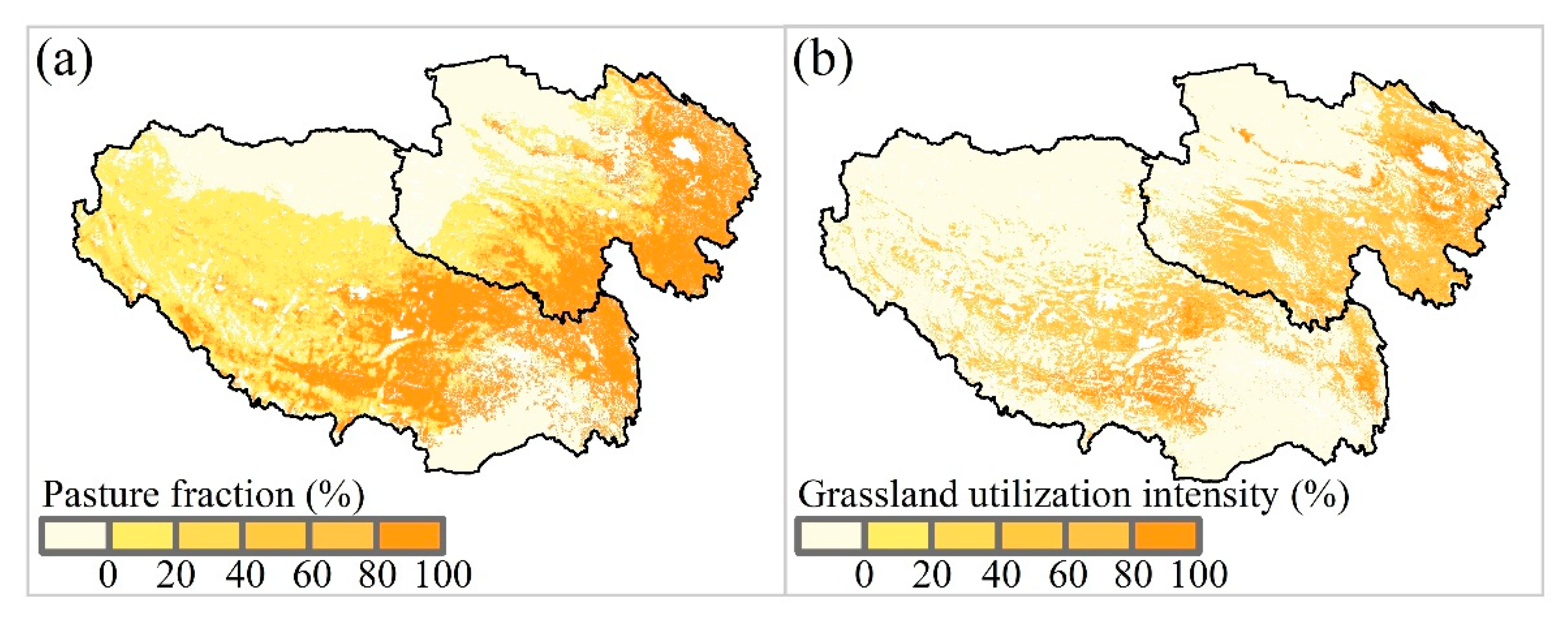
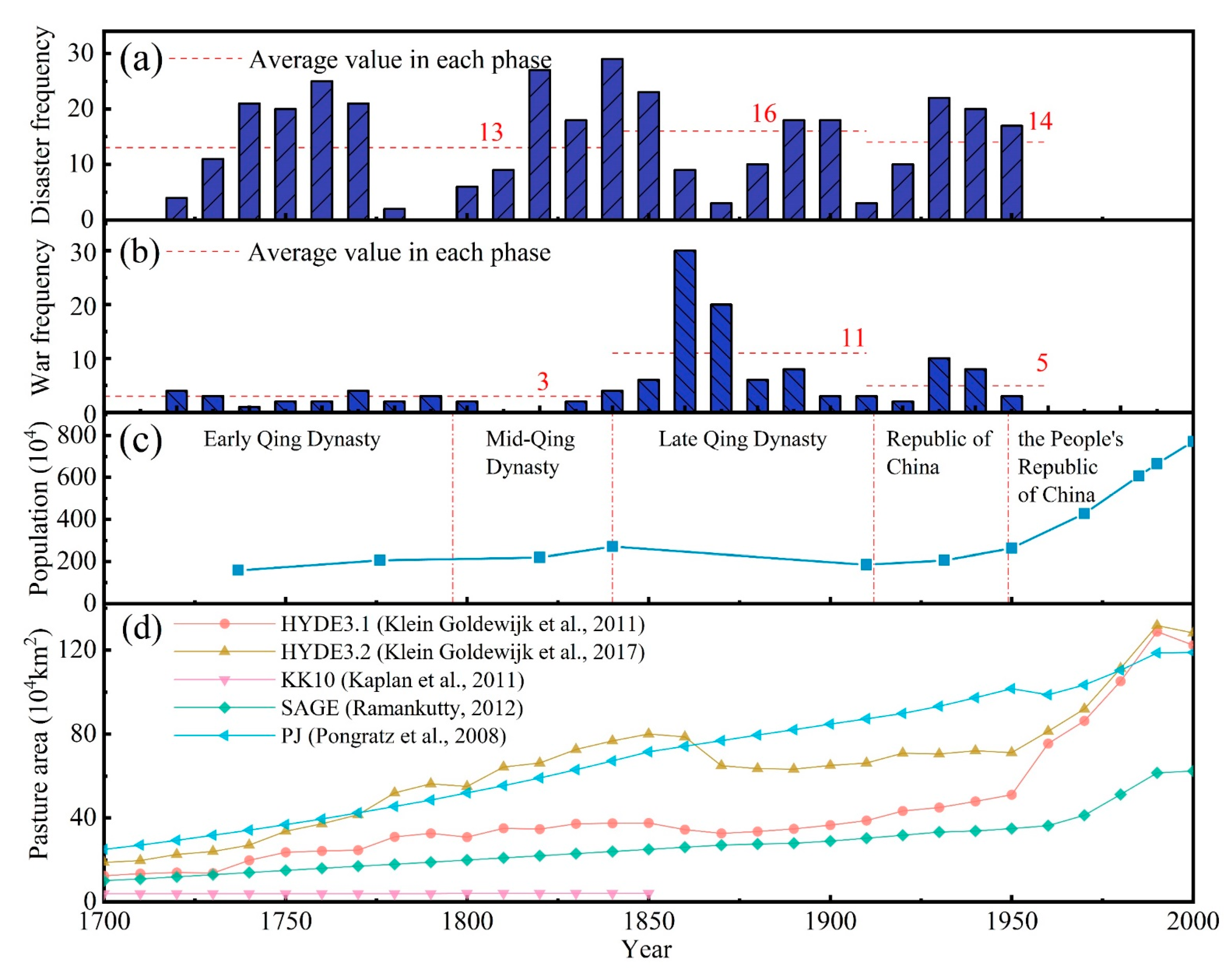
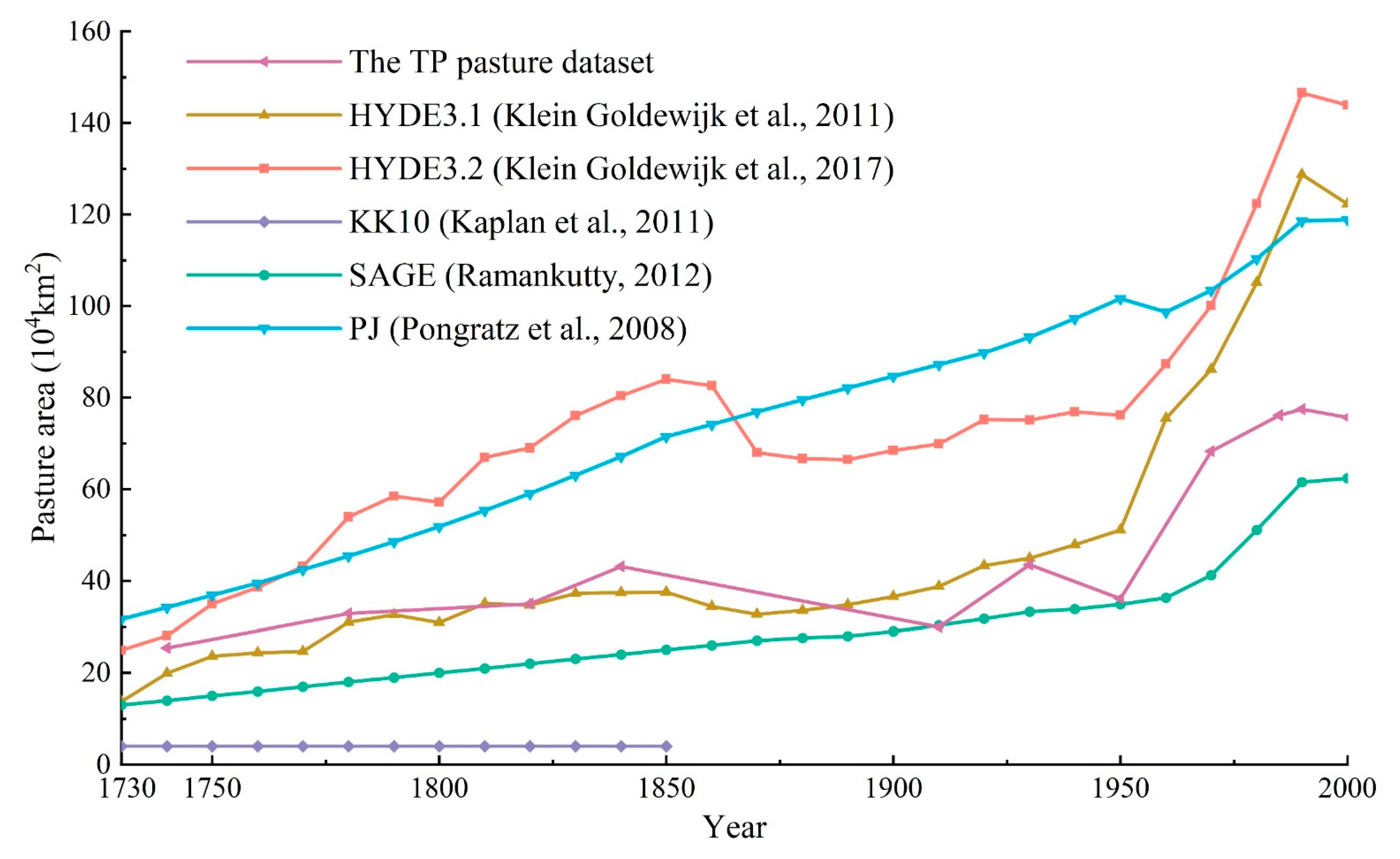
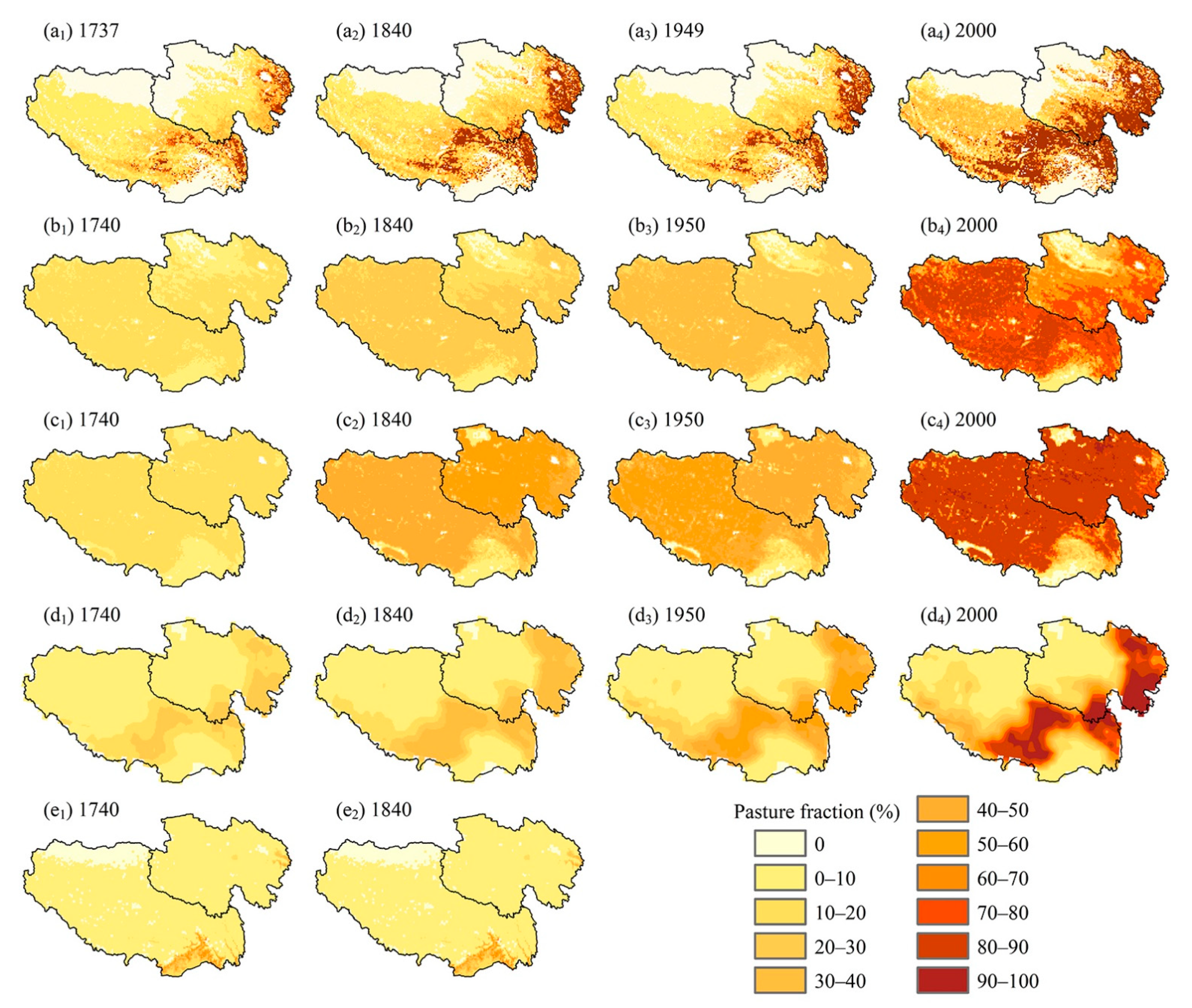
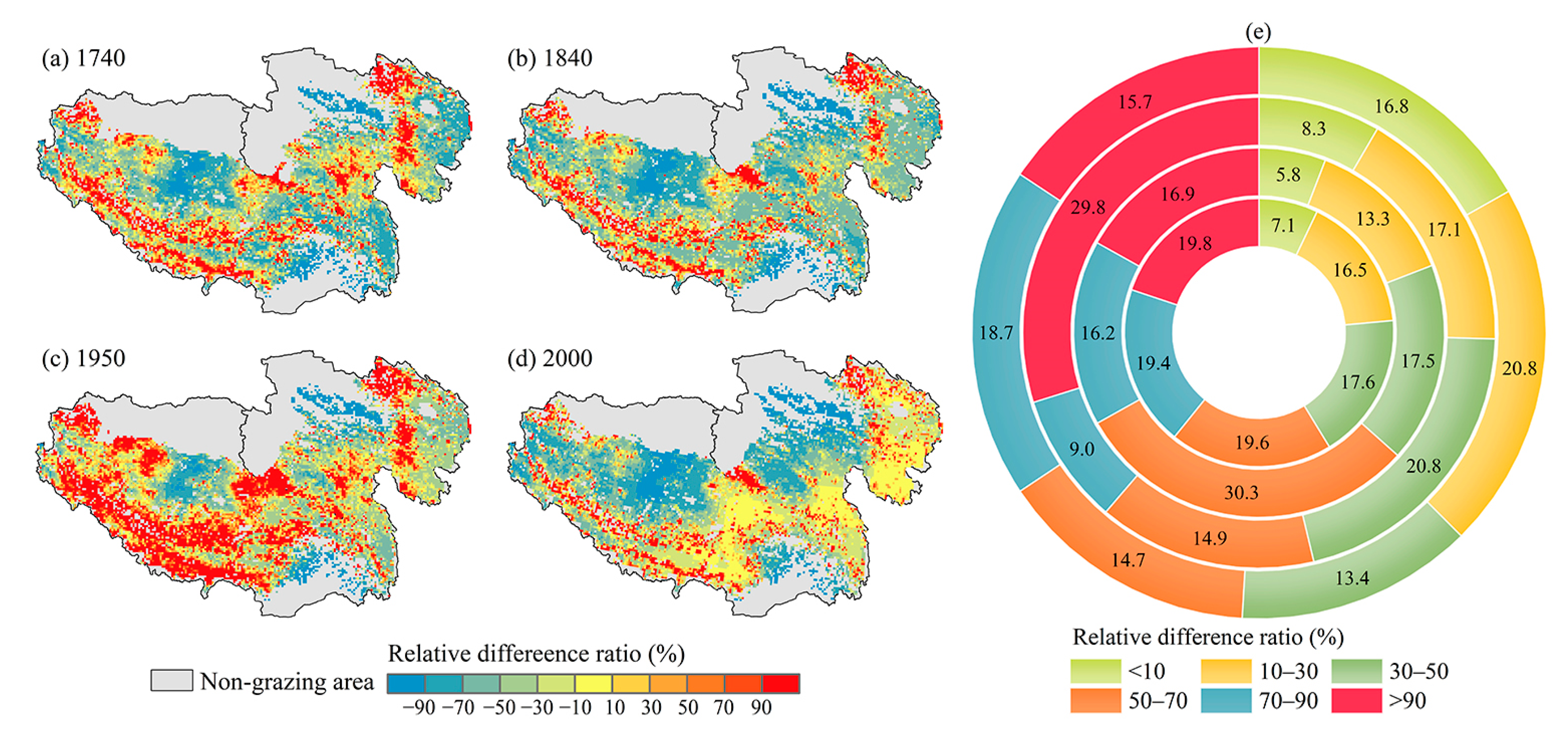
| Datasets | Temporal Coverage | Area Estimation Methods | |
|---|---|---|---|
| Global Datasets | HYDE3.1 [13] | 10000BC–AD2000 | Pasture area per capita, which is assumed stable, is multiplied by population to estimate past pasture area. |
| HYDE3.2 [14] | 10000BC–AD2017 | The historical per capita pasture area was fitted using curves; then, it was multiplied by population to estimate pasture area. | |
| KK10 [19] | 8000BP–AD1850 | Land use area per capita, which is assumed to decrease gradually with the advance of agricultural technology, is multiplied by population to estimate past land use area. | |
| PJ [17] | AD800–1992 | Pasture area per capita, assumed stable for AD800–1700, is multiplied by population to estimate pasture area, and link SAGE and HYDE with the period AD1700–1992. | |
| SAGE [16] | AD1700–2007 | Linear backtracking of pasture area over the historical period, based on the existing inventory data of pasture area. | |
| Regional Dataset | Historical pasture dataset for the TP | AD1737–2000 | Based on the number of livestock and the historical records about the pasture area, we estimated the pasture area for the TP. |
| Year | The TP Pasture Dataset | HYDE3.2 | HYDE3.1 | SAGE | PJ | KK10 | |||||
|---|---|---|---|---|---|---|---|---|---|---|---|
| Area | Area | Ratio | Area | Ratio | Area | Ratio | Area | Ratio | Area | Ratio | |
| 1740 | 25.45 | 27.01 | 1.06 | 19.87 | 0.78 | 13.96 | 0.55 | 34.21 | 1.34 | 3.98 | 0.16 |
| 1780 | 32.86 | 51.94 | 1.58 | 31.03 | 0.94 | 17.97 | 0.55 | 45.42 | 1.38 | 3.99 | 0.12 |
| 1820 | 34.94 | 66.18 | 1.89 | 34.71 | 0.99 | 21.98 | 0.63 | 59.09 | 1.69 | 4.01 | 0.11 |
| 1840 | 43.11 | 76.70 | 1.78 | 37.42 | 0.87 | 23.99 | 0.56 | 67.13 | 1.56 | 4.02 | 0.09 |
| 1910 | 29.94 | 66.16 | 2.21 | 38.75 | 1.29 | 30.35 | 1.01 | 87.21 | 2.91 | ||
| 1930 | 43.50 | 70.52 | 1.62 | 44.92 | 1.03 | 33.27 | 0.76 | 93.18 | 2.14 | ||
| 1950 | 36.08 | 71.15 | 1.97 | 51.06 | 1.42 | 34.89 | 0.97 | 101.63 | 2.82 | ||
| 1970 | 68.23 | 92.00 | 1.35 | 86.19 | 1.26 | 41.28 | 0.61 | 103.40 | 1.52 | ||
| 1990 | 77.45 | 131.67 | 1.70 | 128.74 | 1.66 | 61.47 | 0.79 | 118.62 | 1.53 | ||
| 2000 | 75.62 | 128.12 | 1.69 | 122.29 | 1.62 | 62.36 | 0.82 | 118.83 | 1.57 | ||
Publisher’s Note: MDPI stays neutral with regard to jurisdictional claims in published maps and institutional affiliations. |
© 2022 by the authors. Licensee MDPI, Basel, Switzerland. This article is an open access article distributed under the terms and conditions of the Creative Commons Attribution (CC BY) license (https://creativecommons.org/licenses/by/4.0/).
Share and Cite
Hua, L.; Li, S.; Gao, D.; Li, W. Uncertainties of Global Historical Land Use Datasets in Pasture Reconstruction for the Tibetan Plateau. Remote Sens. 2022, 14, 3777. https://doi.org/10.3390/rs14153777
Hua L, Li S, Gao D, Li W. Uncertainties of Global Historical Land Use Datasets in Pasture Reconstruction for the Tibetan Plateau. Remote Sensing. 2022; 14(15):3777. https://doi.org/10.3390/rs14153777
Chicago/Turabian StyleHua, Lei, Shicheng Li, Deng Gao, and Wangjun Li. 2022. "Uncertainties of Global Historical Land Use Datasets in Pasture Reconstruction for the Tibetan Plateau" Remote Sensing 14, no. 15: 3777. https://doi.org/10.3390/rs14153777





